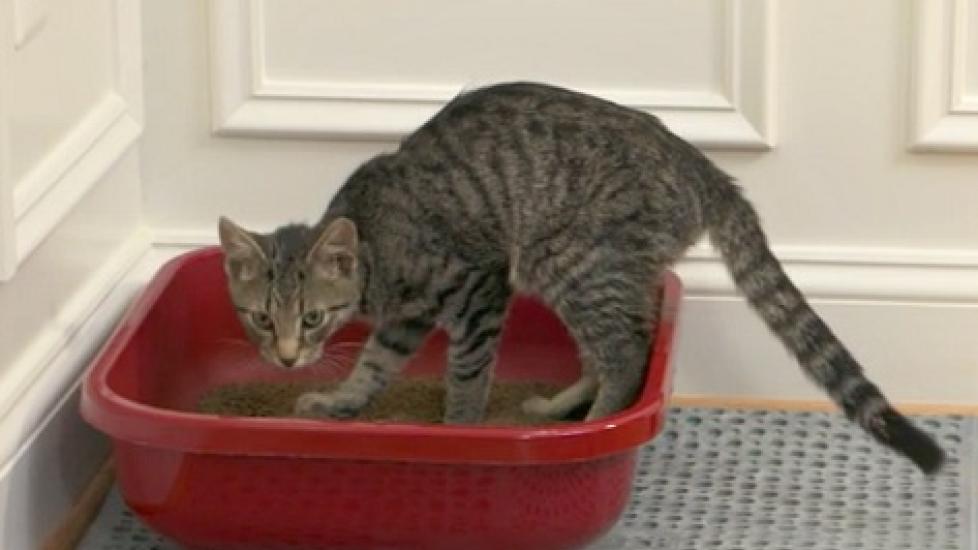Litter Box Training: Why Setup and Placement Matters
By Samantha Drake
Litter box duty is the least pleasant part of having a cat in the house. Cat owners’ efforts to make cleaning the litter box easier in terms of where the boxes are placed, how often they’re cleaned and the kind of litter used, are all-too-often misguided and confusing to cats.
“We mess it up because we make it too complicated,” says Pam Johnson-Bennett owner of Cat Behavior Associates, a private veterinarian-referred behavior practice in Nashville. Johnson-Bennett is a certified cat behavior consultant and the author of eight books on the subject.
Mistakes with litter box set up are made because people think in terms of what they want, not what makes the cat comfortable. But cats’ use of a litter boxes is based on their survival instincts. Covering up their urine and feces is something kittens learn from their mothers to help ensure they don’t attract predators in the wild. “Even our pampered indoor cats have this instinct,” notes Johnson-Bennett.
Here are some tips for setting up your litter box to ensure your cat uses it properly.
Litter Box Training: Setup Basics
The first step in ensuring your cat’s comfort with the litter box is to choose the right litter. Scoopable litter, which is easiest for those doing the scooping, should have a soft, sandy texture because that’s what cats would seek out in the wild, says Johnson-Bennett. Cats are also very sensitive to smell and may turn up their noses at heavily scented litters. To be safe, unscented or minimally scented litter is preferable, she says. If the litter box is kept clean, perfumed litter isn’t necessary anyway.
A household should have one litter box per cat, plus one additional box at a minimum. So if you have one cat, you need at least two litter boxes; for seven cats, you need at least eight litter boxes, Johnson-Bennett explains. In multiple cat homes, the litter boxes should be scattered around the house in easily accessible locations and not grouped together, so that all the cats can use the litter boxes with a feeling of security. No one cat should be able to monopolize access to all the boxes.
Accommodating a cat’s need for security resolves one of the most common litter box questions: Should the litter box be covered or uncovered?
Johnson-Bennett says litter boxes should be uncovered because cats are very vulnerable when using the litter box. While a covered box is more aesthetically pleasing to people and may appear to give the cat privacy, it actually presents a situation in which the cat may feel trapped and unable to escape from a predator, she points out.
Vet Recommended Health Support
- Feliway Optimum Enhanced Calming 30 Day Diffuser for Cats$29.99Chewy Price
- Purina Pro Plan Veterinary Diets FortiFlora Powder Probiotic Digestive Supplement for Cats, 30 count$30.99Chewy Price
- Purina Pro Plan Veterinary Diets Hydra Care Liver Flavored Liquid Supplement for Cats, 3-oz pouch, case of 12$14.99Chewy Price
- Purina Pro Plan Adult Sensitive Skin & Stomach Lamb & Rice Formula Dry Cat Food, 7-lb bag$28.08Chewy Price
Make the Litter Box Easy to Clean
Humans underestimate the importance of keeping the litter box clean. In fact, the number one litter box mistake people make is that they don’t scoop the dirty litter out often enough, according to Johnson-Bennett.
Part of the problem is that our idea of clean is different than a cat’s idea. Cats have very sensitive noses so odor—whether from a dirty litter box or scented litter—can easily put a cat off, explains Johnson-Bennett. Another issue is that people don’t enjoy cleaning litter boxes—it’s smelly, messy, and generally no fun at all. “The litter box is something everyone tries to avoid,” she acknowledges.
Litter boxes should be cleaned “a minimum of twice a day,” Johnson-Bennett says. Ideally, the litter box should be cleaned every time someone walks by and notices there’s something to scoop, she adds. Additionally, all litter boxes should be emptied, washed with soap and warm water, rinsed, dried, and refilled with clean litter at least monthly.
Don’t Hide the Litter Box
Which brings Johnson-Bennett to the next problem. Many people don’t measure up in the cleaning department because the litter box is in the wrong location. Litter boxes are often tucked away and out of sight in basements or little-used areas of the house. A hidden litter box is a lot easier to avoid than one that’s set up in a common area, she explains.
Placing the litter box in a nearby hallway, the corner of the family room, or even a bedroom can go a long way towards keeping it clean. Putting a litter box in the living areas may not seem ideal but an unhappy cat can make living conditions even less pleasant. As Johnson-Bennett points out, “I’d rather have a litter box in my bedroom than a cat peeing on my carpet.”
Also be sure to position the litter box away from the cat’s food and water bowls because no cat—even a coddled indoor cat—wants to eat where it eliminates, she adds.
It’s also a good idea to avoid placing the box near noisy furnaces or laundry machines, since loud noises or odd vibrations may deter cats from using the box.
Litter Box Training No Gimmicks, Please
Finally, Johnson-Bennett warns cat owners that “tricked out” boxes and shortcuts won’t always work for felines. Litter box liners and self-cleaning litter boxes are off-putting for cats, says Johnson-Bennett, and will likely discourage them from using the box.
Training cats to use the toilet is another ill-conceived idea. The concept is unnatural and goes against cats’ instincts, says Johnson-Bennett. Even if a cat learns and accepts the new routine, the training is useless if the cat has to stay overnight at the vet or be boarded. “The toilet is for us, not cats,” she says.




